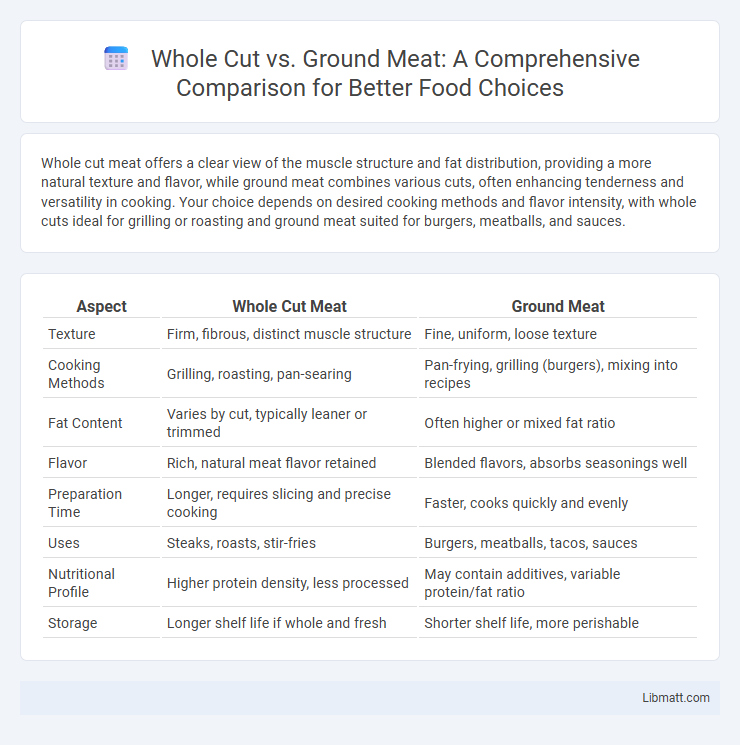Whole cut meat offers a clear view of the muscle structure and fat distribution, providing a more natural texture and flavor, while ground meat combines various cuts, often enhancing tenderness and versatility in cooking. Your choice depends on desired cooking methods and flavor intensity, with whole cuts ideal for grilling or roasting and ground meat suited for burgers, meatballs, and sauces.
Table of Comparison
| Aspect | Whole Cut Meat | Ground Meat |
|---|---|---|
| Texture | Firm, fibrous, distinct muscle structure | Fine, uniform, loose texture |
| Cooking Methods | Grilling, roasting, pan-searing | Pan-frying, grilling (burgers), mixing into recipes |
| Fat Content | Varies by cut, typically leaner or trimmed | Often higher or mixed fat ratio |
| Flavor | Rich, natural meat flavor retained | Blended flavors, absorbs seasonings well |
| Preparation Time | Longer, requires slicing and precise cooking | Faster, cooks quickly and evenly |
| Uses | Steaks, roasts, stir-fries | Burgers, meatballs, tacos, sauces |
| Nutritional Profile | Higher protein density, less processed | May contain additives, variable protein/fat ratio |
| Storage | Longer shelf life if whole and fresh | Shorter shelf life, more perishable |
Introduction to Whole Cut and Ground Meat
Whole cut meat refers to large, intact pieces of muscle sourced directly from an animal, preserving its natural texture and flavor, ideal for roasting, grilling, or slicing. Ground meat consists of finely minced or chopped meat, often mixed from various cuts, offering versatility for recipes like burgers, sausages, and meatballs. Understanding the difference between whole cut and ground meat helps you select the right option for your cooking needs and desired texture.
Defining Whole Cut Meat
Whole cut meat refers to large, intact sections of muscle taken directly from the animal, such as steaks, roasts, or chops, preserving the natural grain and structure of the meat. These cuts offer a distinct texture and flavor due to minimal processing, allowing for more control over cooking methods and doneness levels. Your choice between whole cut and ground meat impacts both the taste profile and cooking versatility, as whole cuts retain more moisture and provide a premium eating experience.
Defining Ground Meat
Ground meat is meat that has been finely chopped or minced using a grinder, allowing for uniform texture and faster cooking times compared to whole cuts. Whole cut meat refers to unprocessed muscle cuts like steaks, roasts, or chops, which retain their natural structure and require slicing or tenderizing before cooking. Understanding the distinction helps you choose the right type for recipes based on texture, flavor concentration, and cooking methods.
Nutritional Differences
Whole cut meat generally retains more nutrients such as iron, zinc, and B vitamins compared to ground meat, which can experience nutrient loss during processing. Ground meat often has a higher fat content due to added trimmings, influencing caloric density and saturated fat levels. Protein quality remains high in both forms, but whole cuts typically provide leaner options with less exposure to oxidation and contamination risks.
Texture and Flavor Contrast
Whole cut meat offers a firmer texture and more distinct muscle fibers, enhancing the chewiness and natural beef flavor through caramelization during cooking. Ground meat provides a uniform texture with increased surface area, allowing spices and seasonings to penetrate evenly, resulting in a juicier and more flavorful bite. The contrast between whole cut and ground meat lies in the balance of texture complexity and flavor intensity, catering to different culinary needs.
Cooking Methods and Applications
Whole cut meat offers versatility for roasting, grilling, and pan-searing, preserving texture and flavor ideal for steaks, chops, and roasts. Ground meat, composed of minced muscle, is optimal for quick cooking methods like sauteing, frying, and broiling, commonly used in burgers, meatballs, and sauces. Understanding these differences enhances recipe outcomes, as whole cuts develop a seared crust and retain juiciness, while ground meat cooks evenly and absorbs seasonings thoroughly.
Health and Safety Considerations
Whole cut meats retain their natural muscle structure, reducing exposure to surface bacteria and lowering the risk of contamination compared to ground meat. Ground meat undergoes extensive mechanical processing, increasing the surface area and potential for bacterial growth, making it more susceptible to pathogens like E. coli and Salmonella. Proper cooking and handling practices are crucial for ground meat to ensure safety, while whole cuts require less stringent cooking temperatures to achieve safe consumption.
Cost and Accessibility
Whole cut meats generally cost more due to higher quality and less processing, but they offer superior flavor and texture ideal for specific recipes. Ground meat is more affordable and widely accessible across various retail outlets, often available in bulk or smaller portions. Consumers choose ground meat for budget-friendly, versatile cooking, while whole cuts suit those prioritizing culinary precision and presentation.
Consumer Preferences and Trends
Consumer preferences increasingly favor whole cut meat for its perceived quality and traceability, appealing to those who prioritize freshness and texture in their meals. Ground meat remains popular due to its versatility and convenience, fitting seamlessly into various recipes and faster meal preparations. Understanding your preference for either whole cut or ground meat can enhance your culinary experience, aligning with current trends that balance health consciousness and cooking ease.
Choosing the Right Meat for Your Needs
Whole cut meat retains its natural texture and flavor, making it ideal for dishes requiring precise cooking control and tender results. Ground meat offers versatility and convenience, perfect for recipes like burgers, meatballs, or sauces that benefit from uniform blending. Understanding your cooking method and desired texture helps you choose the right meat to enhance your culinary outcomes efficiently.
Whole Cut vs Ground Meat Infographic

 libmatt.com
libmatt.com